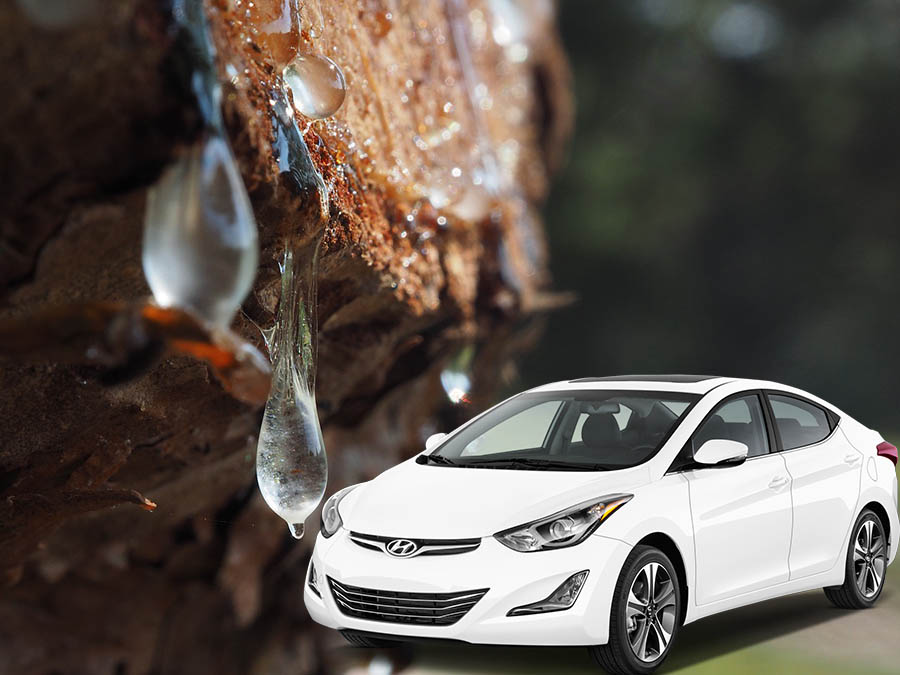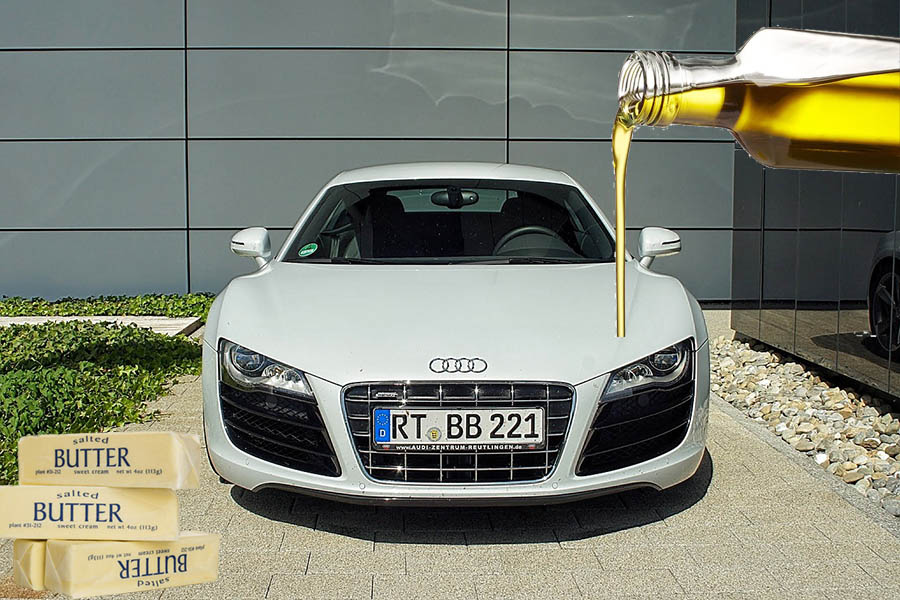If you park your car frequently under trees, you may get tree resin on the car paint. Unfortunately, the resin usually sticks to your car very stubbornly and can also attack the paint. Therefore, you should start cleaning your car as soon as possible.

Remove tree sap from the car with household remedies
Basically, you should remove tree sap from the car as soon as possible. The longer the resin sticks to the paint, the more difficult it will be to remove the resin without the paint being damaged.
It is best not to park under trees at all. If you have no other option due to a lack of parking space, you should check the vehicle carefully before you get in. If you discover resin stains on the paint, you should immediately go to the next car wash.
Otherwise, wash the car yourself thoroughly with hot water as soon as possible. The softer the resin is, the easier it is to remove. If you don’t get all the resin from the tree, place wet, hot rags on the resin stains for about a minute. The heat softens the resin and makes it easier to remove afterwards.

A simple door lock deicer is a useful home remedy for tree stains. Apply a few drops of door lock deicer to the tree stain and let it soak in for a few minutes.

It is also often helpful if you rub the resin stain well with fat – for example in the form of butter, margarine or cooking oil. After the substance has acted for some time, wipe the tree resin with a soft cloth.
Conventional cleaning agents and after-treatment
If the resin is already older and dried, you can also try your luck with cleaning clay. As a rule, you get the tree resin with the cleaning clay relatively well. However, you should be particularly careful with black paint and special paints.

The use of special tree resin removers usually works without problems. If you often park under trees, it is definitely worth having a can of them and a microfiber cloth in the glove compartment.
Once you have removed the tree resin, clean it again with a varnish polish.
Finally, maintain and seal your car paint with a good car wax so that it is better prepared for a new tree resin attack.
Just soapy water doesn’t always work
Anyone who has ever tried to remove the white to tan sticky resin stains from the car knows how tedious this work can be and how unsightly the results are often. Dried drops in particular are an abomination for every vehicle owner. Simple soapy water is hardly enough to remove the resin and get the car clean again. If you also overdo it with scrubbing, you quickly ruin the paint.

But whoever has the damage should act quickly and immediately tackle the tough, stubborn mass. Because the fresher the tree resin, the easier it is to remove it from the car. However, driving through the car wash often does not completely solve the problem. Even with dried stains, even the best car wash will fail. Often only manual work is required here. With smaller residues, it usually helps to treat the paint with an auto polish.
First of all, the vehicle should be washed and cleaned of dirt, because sand and dust can leave scratches on the paintwork. Under no circumstances should you work with an acidic cleaner, as this could damage the sensitive paint. After washing, the best way to remove the resin from the car paint is to use tar remover. Gentle pressure is required, since the paint is already attacked by the adhesive. But be careful! If it is not the original paint, it can happen that the tar remover removes the paint.

Caution should also be taken with resinized rubber seals. Under no circumstances should these be treated with a polish, since the abrasives they contain attack the rubber. It is also best here to work with a light solvent and then apply rubber care.
A fresh resin stain can also be easily combated with fat. To do this, put a little oil on the stain and rub in gently. Then you take a microfiber cloth and water and detergent to gently remove the tree resin from the car.
Special cleaning clay is also an effective method. However, this should only be used on damp paint and with great care. Especially in vehicles with black paint, so-called hologram effects can occur if the pressure is too tight. Such “small paint scratches” then look extremely unattractive.
Tip: In particular conifers secrete a lot of resin. If you park often under such trees, you should consider professional nano sealing of the paint. The resulting protective layer prevents tree resin and other dirt from sticking and the vehicle is easier to clean.
Video: Remove tree sap with hand sanitizer
Parking under trees can be expensive
If you park your car under trees, you can expect unpleasant surprises from above. This not only damages the paint. It can also be expensive for drivers – especially if branches fall.

A shady parking lot under trees is a stroke of luck on hot days. At least at first glance, but it gets annoying when the car is covered with a sticky layer when you return.
This is a matter of aphid, also known as honeydew. The varnish is generally not attacked by honeydew. A car wash is therefore sufficient to remove the sticky film. There are no traces. It’s different with resin. The natural substance is chemically comparable to car paint. At high temperatures, the paint and resin can literally bond, which damages the upper protective layer. Resin stains should therefore be removed immediately. There are special wet wipes that contain harmless solvents that can serve this purpose.
Bird droppings can be at least as aggressive for car skin. The excrement contains, among other things, the substance ferment pancreatin, which can cause permanent damage, especially if a stain is not removed for several days and the sun is shining strongly.
Modern varnishes are being intensively tested. For this purpose, the paint manufacturers use special gradient ovens in which the paints are exposed to high temperatures, also in connection with resins or tar. However, it cannot be ruled out that the protective layer on the car will be damaged.
When cleaning the paint, drivers can do a lot wrong: from thinners to other harsh cleaners. Drivers should generally not use any harsh cleaning agents because they can damage the paint. In addition, no dishwashing detergent should be used when cleaning windows. This promotes droplet formation and is hydrophobic. The water later drips off while driving instead of wetting the window. This can impair visibility when the wiper blades are working. If you park under the tree, you can expect worse than just bird droppings or tree sap. Tree branches can break off and damage the entire car. Motorists usually stay on the expense, provided the tree is cared for and the owner fulfills his road safety obligations. As a rule, this consists of carrying out a visual check twice a year and taking measures to protect against branch breakage and the like. However, when a branch falls, it is often considered a natural event, legally speaking.
Damages caused by nuts or chestnuts are usually classified by courts as “natural hazards”. Tree owners only need to give a warning if there is an acute hazard, for example after a storm caused by broken branches.
Ultimately, car owners usually only have to go to their own insurance. If there is a comprehensive car insurance that includes the services of a partial car insurance, the affected party can also use it for damage caused by a natural, unpredictable branch break or fruit falling. On the other hand, the purely partial car insurance covers only elementary damage – caused, for example, by hail or storms from wind force eight.
In principle, minor paint damage can be eliminated in the workshop. Dents are dented without having to remove vehicle parts. However, drivers can save themselves a visit to the workshop or time-consuming cleaning right from the start: if they have the patience to find a parking space and do without the comfortable place under the tree.










The car is America’s favorite child… now get some baby oil :p
And if you don’t have a baby and therefore probably don’t have any baby oil, take butter or margarine.
I would have tried diesel. Diesel is also a “universal cleaner” for many things. 🙂
Baby oil definitely sounds better than professional scrubbing with the sponge, using the high-pressure cleaner at a distance of 2mm or scratching with your fingernail.
Tried nail polish cleaner on the windows, works fine! But you should wash with glass cleaner or degreaser afterwards.
I’d like to know how the tree sap gets on the inside of my car when it’s locked in a garage all night.